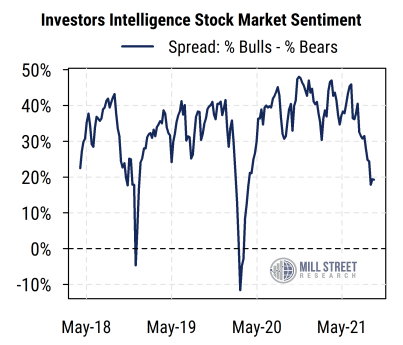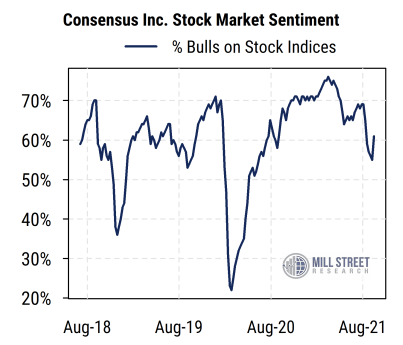21 October 2021
The S&P 500 recently had its biggest pullback since March, though only about 5% from its early September all-time high and thus quite mild in the context of normal market volatility historically. The Russell 2000 has not hit a new high since mid-March but was also only about 5% off that peak, having been mostly range-bound since then. Major indices have since recovered much of those declines in the last week and are again approaching their highs.
As we have discussed with clients, surveys of investor sentiment have shown a more dramatic decline in bullishness on stock prices than one might expect given the market’s moderate correction.
The widely-watched Investors Intelligence survey now shows the proportion of outright bulls on stocks outnumbering outright bears (ignoring the “correction” group) by only 19% at the latest reading (chart below). This is down sharply from a recent peak of 46%, and now well below the five-year average of about 34%. Typically such large drops in sentiment have followed more significant market pullbacks or volatility (i.e., more than just a 5% pullback).
 Source: Mill Street Research, Investors Intelligence
Source: Mill Street Research, Investors Intelligence
A similar picture can be seen in the survey data from Consensus Inc. on the proportion of bulls on US stock indices (chart below). Before this week’s uptick, the prior week’s reading of 55% bulls was down from an April peak of 76%. That marked a 21% decline in bulls even though the S&P 500 was, even at its recent low, actually still about 4% higher than it was in April when the bulls were at a peak. The average reading over the last five years has been about 63% bulls, so the recent low reading was also notably below average. The latest uptick follows the market’s rebound over the last two weeks, but is now only back to the longer-term average level.
 Source: Mill Street Research, Consensus Inc.
Source: Mill Street Research, Consensus Inc.
Our take on these sentiment readings has been that investors have been quick to turn more cautious on a mild correction after such a big, uninterrupted run in leading indices such as the S&P 500 and NASDAQ-100. Headlines have been especially worrisome recently (supply chain, political sand in the fiscal policy gears, COVID, etc.), building up the proverbial “wall of worry”. However, earnings estimates continue to rise (though at a more moderate pace) and real interest rates are still historically low.
While sentiment is always tricky to use as a timing tool, the current alignment of sentiment, price, and fundamentals looks like sentiment is more cautious than would be expected, and thus a potentially favorable contrarian indicator. There could be more near-term volatility, but our indicators overall remain positive and thus we would maintain our long-standing overweight equity positions.